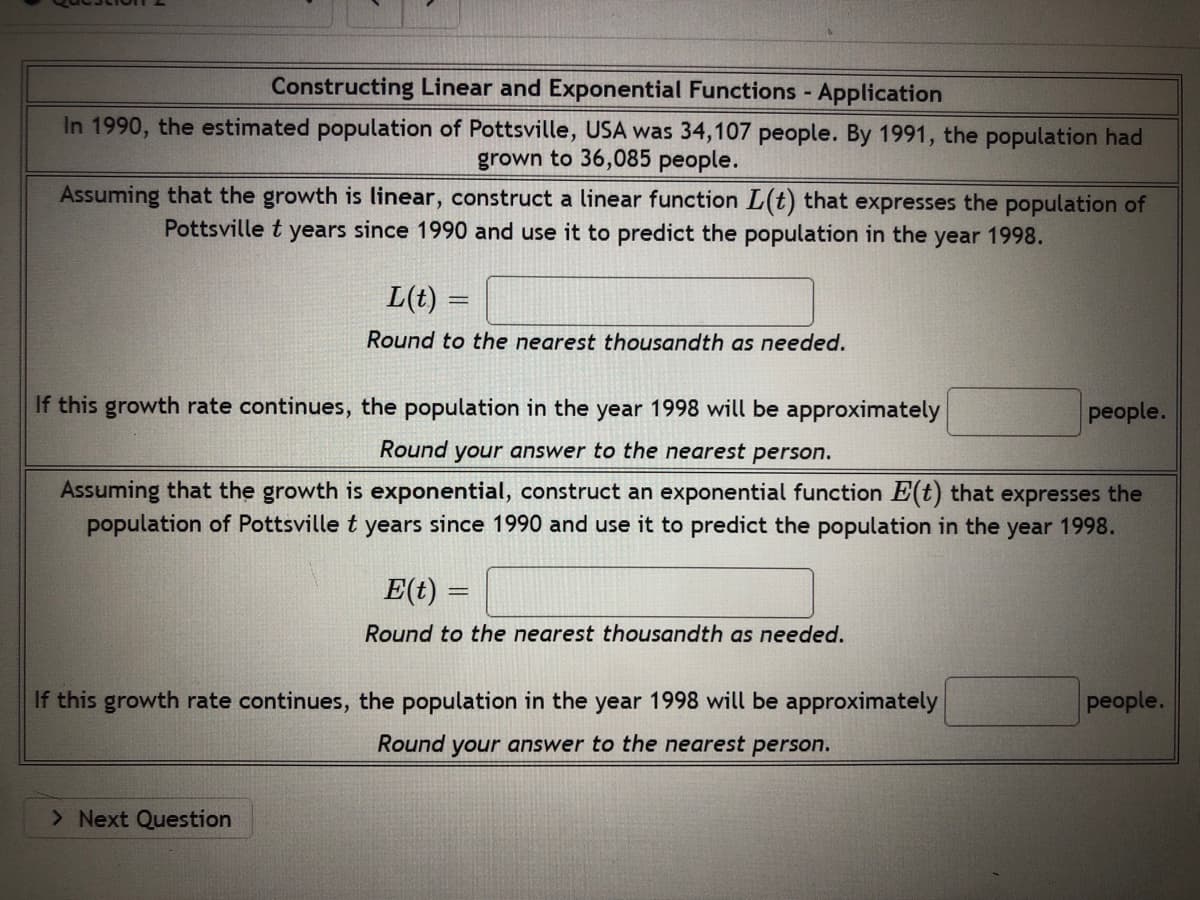Constructing Linear and Exponential Functions - Application In 1990, the estimated population of Pottsville, USA was 34,107 people. By 1991, the population had grown to 36,085 people. Assuming that the growth is linear, construct a linear function L(t) that expresses the population of Pottsville t years since 1990 and use it to predict the population in the year 1998. L(t) = %3D Round to the nearest thousandth as needed. If this growth rate continues, the population in the year 1998 will be approximately people. Round your answer to the nearest person. Assuming that the growth is exponential, construct an exponential function E(t) that expresses the population of Pottsville t years since 1990 and use it to predict the population in the year 1998. E(t) = Round to the nearest thousandth as needed. If this growth rate continues, the population in the year 1998 will be approximately people. Round your answer to the nearest person.
Constructing Linear and Exponential Functions - Application In 1990, the estimated population of Pottsville, USA was 34,107 people. By 1991, the population had grown to 36,085 people. Assuming that the growth is linear, construct a linear function L(t) that expresses the population of Pottsville t years since 1990 and use it to predict the population in the year 1998. L(t) = %3D Round to the nearest thousandth as needed. If this growth rate continues, the population in the year 1998 will be approximately people. Round your answer to the nearest person. Assuming that the growth is exponential, construct an exponential function E(t) that expresses the population of Pottsville t years since 1990 and use it to predict the population in the year 1998. E(t) = Round to the nearest thousandth as needed. If this growth rate continues, the population in the year 1998 will be approximately people. Round your answer to the nearest person.
Trigonometry (MindTap Course List)
10th Edition
ISBN:9781337278461
Author:Ron Larson
Publisher:Ron Larson
Chapter5: Exponential And Logarithmic Functions
Section5.5: Exponential And Logarithmic Models
Problem 30E: Population The table shows the mid-year populations (in millions) of five countries in 2015 and the...
Related questions
Question

Transcribed Image Text:Constructing Linear and Exponential Functions - Application
In 1990, the estimated population of Pottsville, USA was 34,107 people. By 1991, the population had
grown to 36,085 people.
Assuming that the growth is linear, construct a linear function L(t) that expresses the population of
Pottsville t years since 1990 and use it to predict the population in the year 1998.
L(t) =
Round to the nearest thousandth as needed.
If this growth rate continues, the population in the year 1998 will be approximately
people.
Round your answer to the nearest person.
Assuming that the growth is exponential, construct an exponential function E(t) that expresses the
population of Pottsville t years since 1990 and use it to predict the population in the year 1998.
E(t)
Round to the nearest thousandth as needed.
If this growth rate continues, the population in the year 1998 will be approximately
people.
Round your answer to the nearest person.
> Next Question
Expert Solution
This question has been solved!
Explore an expertly crafted, step-by-step solution for a thorough understanding of key concepts.
This is a popular solution!
Trending now
This is a popular solution!
Step by step
Solved in 2 steps with 2 images

Recommended textbooks for you

Trigonometry (MindTap Course List)
Trigonometry
ISBN:
9781337278461
Author:
Ron Larson
Publisher:
Cengage Learning

Functions and Change: A Modeling Approach to Coll…
Algebra
ISBN:
9781337111348
Author:
Bruce Crauder, Benny Evans, Alan Noell
Publisher:
Cengage Learning

Algebra & Trigonometry with Analytic Geometry
Algebra
ISBN:
9781133382119
Author:
Swokowski
Publisher:
Cengage

Trigonometry (MindTap Course List)
Trigonometry
ISBN:
9781337278461
Author:
Ron Larson
Publisher:
Cengage Learning

Functions and Change: A Modeling Approach to Coll…
Algebra
ISBN:
9781337111348
Author:
Bruce Crauder, Benny Evans, Alan Noell
Publisher:
Cengage Learning

Algebra & Trigonometry with Analytic Geometry
Algebra
ISBN:
9781133382119
Author:
Swokowski
Publisher:
Cengage


College Algebra
Algebra
ISBN:
9781305115545
Author:
James Stewart, Lothar Redlin, Saleem Watson
Publisher:
Cengage Learning